Yamaha Xeno Cornet: YCR8335G
6-Dec-20054BR has finally got its hands on a Xeno cornet to see what all the fuss is about. Is it as good as it sounds or have we all been hoodwinked into believing the hype? This what we thought.

The instrument was lent to us by Trevada Music, where it can be purchased.
See the bottom of this page for more details on Trevada Music.
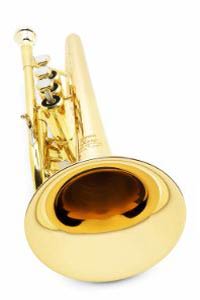 Introduction:
Introduction:
There is little doubt that no other Japanese import has created such a fuss as the new Xeno Cornet from Yamaha since the Sony Play Station hit our shores a few years. Suppliers have been waiting with sweaty hands and bated breath to get their hands on what Yamaha's Charles Bozon described as ‘…a world beating instrument.'
Developed over the past two and half years in conjunction with leading brass performers, especially Professor David King, it is the makers new flagship cornet product, aimed at the very top end of the market place as a challenger to the previously all conquering ‘Prestige' from Besson and as a long term replacement for the well respected and popular ‘Maestro' range.
Yamaha has known that for some time it has had ground to make up with its leading cornet brand and it has therefore taken the bold step of producing a brand new model rather than tweak and tinker with the existing instrument in an attempt to produce a new industry leader. The ‘Maestro' was a very good instrument, but it had a number of inherent flaws that ensured that it was seen as a worthy but unspectacular cornet. It had all the attributes but lacked a certain charisma – a bit like a musical version of a Toyota Lexus; great car, but bland and rather too conservative in outlook and just lacking that cutting edge performance.
Now comes the Xeno – following on from the previous launches of Yamaha's trumpet range that has received very good reviews indeed. Would this finally give Yamaha the cutting edge tool of the brass band trade to tempt top class players to trade in their existing Maestro's or more crucially dump their ‘Prestige' or ‘Courtois' models in the bin? Or would it just be more of the same we have come to expect from the Land of the Rising Sun?
If the hype is anything to go by, then suppliers should be inundated with requests for a test run and an order in time for Christmas.
4BR has been very fortunate indeed to get its hands on a Xeno cornet for the past couple of weeks from our friends at Trevada Music who are one of the first suppliers to get the Xeno in their shops. They have been mightily impressed by what it has to offer, so was 4BR going to be bowled over?
As usual we put the instrument through its paces and marked it out of 25 in four main sections to give an overall total out of 100.
Those categories are: Build Quality and Design; Intonation; Ease of Blowing and Tonal quality and finally, Overall performance and value for money.
We played on the Yamaha Xeno cornet YCR8335G with lacquered finish (Bright Silver Plate is also available on the YCR8335GS model), but we did not test it with the bespoke David King mouthpiece that comes with the instrument as we believe that the vast majority of players would not change their existing mouthpiece if they purchased one.
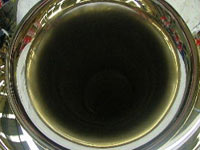 Build Quality/Design:
Build Quality/Design:
One of the major plus points to any Yamaha instrument over the years has been the build quality and especially the finish. With the Xeno, if anything, that quality has been further enhanced and developed so that we now have an instrument that has been put together to the highest production standards. The design meanwhile, although not revolutionary has taken a major leap forward evolution wise.
The first thing you notice is the slightly sleeker slightly more linear look to the Xeno. Put it up against a Maestro and it looks as if it has had a bit of nip and tuck work and it makes it a much more attractive instrument to the eye. Designer Thomas Lubitz has done a very good job indeed.
In the hand, the centre of balance has been slightly shifted so that it now has a more neutral feel (the Maestro like most of the Yamaha cornet range tended to be slightly bell heavy) and although we were unable to weigh the instrument, it was sturdy – not over heavy, but reassuringly solid.
All the tolerances are excellent: the slides are snug yet secure, the valves have a real quality feel and look as if top notch materials have been used in their construction (as well as for the heavy valve tops and caps) and are balanced and free moving. The triggers are neatly designed, the water keys have the feel of quality and the lacquer finish in particular is excellent – not a smear, shadow or bleed anywhere to be seen.
There are also specific designs features that differentiate the instrument from its predecessor: The leadpipe has been radically and totally redesigned as has the bell, whilst there are subtle changes in the main water key which has a more elongated capture well and the first slide trigger which has a new design that incorporates a newly positioned nodule point that the makers state allows for a much more free flowing use and less tolerance to the air flow through the instrument.
It is also a much more rigid instrument as well, with a newly positioned strut attaching the bell and lead pipe as well as additional struts on the top of the valve casings (two instead of one) that does give it a firmer feel.
It is nice to report that you don't need hands like shovels either to use the triggers with ease. The valves are Monel hand lapped and very slick and quiet and the little things like the felts and valve tops and bottoms now appear to have been made with thought and care.
The slides have plenty of travel if required and all in all it adds up to an impressive package indeed.
Overall: Very impressive to the eye and the hands with high quality materials put together with high quality standards of production: 23 points
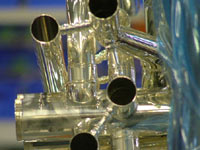 Intonation:
Intonation:
The Yamaha certainly looks the part, but how did it play?
We must say we were very impressed. It is difficult at times to wonder if it is the player or the instrument that makes you play in or out of tune, but in general, for an instrument to be of any use it must not just be approximately in tune – it must be very accurately in tune.
Then the player, if he or she is of an appropriate standard can minimally adjust their input to make it 100%. You don't need to be fiddling about pulling the main tuning slide in or out like Don Lusher to get things in check, or waggling your thumb on the first slide trigger as if you are text messaging to a friend. Just the smallest subtle changes make all the difference.
This is what we found here. The mid range was as near perfect as you could hope to find. Bottom C, invariably the trigger point to poor intonation felt neutral rather than sharp whilst the same could be said going through the chromatic scale. Trying it against one of those tuning machines and even then you will see it is as near as damn it to being bang on the money.
Above the stave it was also very good indeed. Top G, A and B all felt spot on, whist top C and D (played on first valve no less) were also as good as we hoped for. A little judicious use of the first slide trigger helped, but there was no need to more than slightly touch it in order to keep things under control when you started the bellows up and pushed the air through to up the dynamic levels.
Below and around the stave was more of the same – no noticeable problems on the dreaded C# and D natural or when dropping into the depths down to bottom F#. The triggers can be used to help, but again it is not a question of trying to extend them as if you were on Torquemada's rack.
Quiet dynamic playing is a joy too as the intonation remains true even when the airflow is reduced throughout the range.
Overall: Very impressive indeed: 23 points
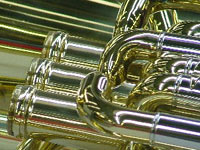 Ease of Blowing/Tonal Quality:
Ease of Blowing/Tonal Quality:
You should always be sceptical of sales blurb. The Yamaha has been sold as producing what they call ‘Solar' sound, and that it signifies the unique blending of both warmth and brightness whilst fulfilling the ambitious objective in aligning greater power and projection whilst maintaining rich quality of sound.
It is complete and utter nonsense and the type of blurb advertising executives dream up in moments when they have to justify their fees to the company they are doing the PR for. ‘Solar Sound' – come off it. Next we will hear of ‘Lunar Sound' or ‘Earth, Wind and Fire' sound. If a salesperson even mentions the term to you, then you should either laugh out loud or punch him on the nose with the words – ‘How does that sound then?'
Away from the nonsense we put the instrument through its paces and without ever mentioning the solar power we were suitably impressed.
Much of the credit must go once again to the designer who has certainly taken on board the more obscure requirements of performers (leading players have very specific requirements, but turning them into something that appeals to a more general customer base is a real art) and turned the instrument into a free blowing, warm and secure instrument – just what traditional cornet players desire.
The leadpipe development has certainly got something to do with this: its more flared appearance suggests a much more free passage of air from mouthpiece into the instrument and with a new inventory it allows greater flow.
The development of the bell is plasuma welded taper in 1 piece with French beading and with the choice of two metal options (including Gold brass) does give it a sense of freedom that was lacking on the Maestro in particular.
You can really project your sound without recourse to overblowing and when you do wish to up the dynamic ante the instrument has the resistance to cope with all that you throw through it. At the other end of the scale it also retains its security when you turn the airflow tap towards the off – a real plus.
The quality of the materials also means that the instrument does not sound ‘tinny' either. This is a large bore instrument that does not sound as if you are trying to fill a bucket with spit, and although we are sure it has a limit, you need to have lungs like Lance Armstrong to get even close.
A good player will also be able to explore more of the tonal qualities the Xeno has to offer. It has a natural warm bright sound but it can be darkened or lightened even further by judicious use of vibrato and airflow. As it comes it gives a full traditional cornet sound, but that flexibility to the accomplished performer is a real plus point.
Overall: Forget the blurb and concentrate what it actually has to offer and you have a very good cornet with bags of almost limitless potential: 23 points
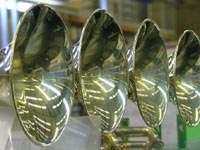 Overall performance /Value for money:
Overall performance /Value for money:
Quality doesn't come cheap – and why should it, and even though the Xeno may have been as rare as the proverbial rocking horse manure, the suppliers have now started to get their hands on them and are doing deals.
This is certainly a premium instrument so if you can get a deal then snap one up as fast as you can.
The build quality is as good as anything the Germans could come up with if Mercedes ever thought about going into the cornet making business whilst the design is excellent and the materials and finish are of a very high standard.
As the instrument is aimed at the top end of the market it is geared towards accomplished players who will find its intonation to be secure and the ease of blowing and tonal quality a bonus. Put this in the hands and on the lips of even a top class cornet player and it will enhance their playing significantly if they use their noggin.
Overall the instrument has a great deal to live up to considering the hype that has gone with its launch, but it doesn't have to rely on gimmicks to sell itself (apart from the rubbish Solar sound nonsense). The instrument we tried did not come with a lyre although there is a good lyre point, and as we have said, the inclusion of a David King mouthpiece is a nice bonus addition but nothing more.
Yamaha provide a quality case as well: sturdy and well padded with excellent locks (with two keys) and a handle which won't fall off after a month. The case itself will more than take the knocks and bangs of being thrown on the back of the band bus or being used as an impromptu card table, whilst it does have enough room in it for three mutes, although you will still have to carry your music separately. The Xeno also comes with a useful booklet on instrument care, cleaning cloth and a small tub of slide grease.
Overall: Real quality and perhaps the new market leader: 23 points
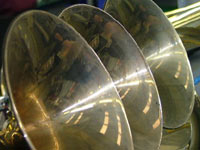
Overall Comment:
The Xeno has certainly lived up to expectations for us and given the amount of care and attention to detail and for the producers asking for the opinions of leading brass band players and educators (rather than just orchestral performers) we get an instrument very much with a specific market and specific performer in mind.
It is difficult to find fault – apart from the ludicrous ‘Solar Sound' and we think this is going to be a very stern challenger in the current market place.
It deserves it success.
Overall Total:
Build Quality and Design: 23 points
Intonation: 23 points
Ease of Blowing and Tonal quality: 23 points
Overall performance and value for money: 23 points
Overall Score: 92 points
Specification:
Yamaha Xeno cornet YCR8335G
RRP: £1,849.00
Trevada Music currently have the instrument for sale at £1,200.00 for the lacquer model and £1,230.00 for the Bright Silver Plate.
Please contact:
Trevada Music
9 Chapel Street
Camborne
Cornwall
TR14 8EF
Tel: 01209 714353
Fax: 01209 718708
Trevada Music
Shoppers World
18 Wind Street
Ammanford
Carmarthenshire
SA18 3DN
Tel: 01269 596607
Fax: 01269 596608









